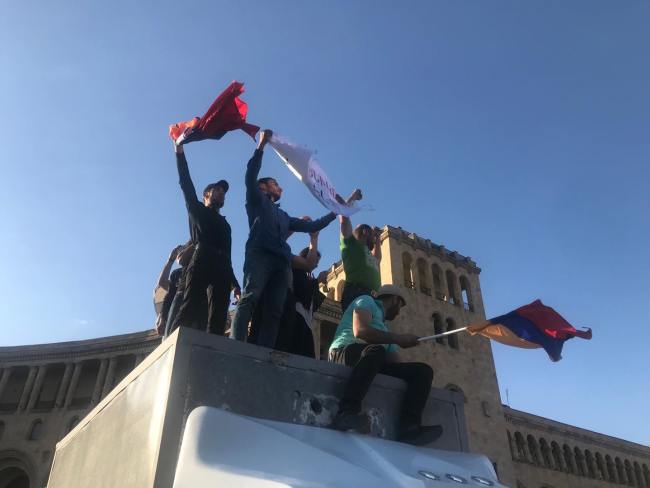Photo Credit: Armine Avetisyan
Armenia – a small, former-Soviet nation in the Caucasus – may have been an unlikely site for a massive movement of people power. But this spring, it became exactly that. When the country’s president made a strong and antidemocratic power grab, the people shut it down. Through persistent, peaceful protest and an unwavering insistence on their values, Armenians succeeded – quickly. Armenia’s ‘Velvet Revolution’ is a reminder to the world that everyday people hold a tremendous amount of power – and that even in the face of great adversity, their voices can be heard.
How it began
Serzh Sargsyan had been in power for the past decade in Armenia. He served twice as president, reaching the country’s term limit, and then stepped down on April 9 at the inauguration of his successor. In a healthy democracy, the peaceful transfer of power would have been the natural end of his career in the country’s highest position of leadership.
In this small former-Soviet state, however, the institutionalization of the government had proven itself vulnerable to the autocratic ambitions of a strong leader. That’s because a structural shift in 2015 demoted the role of the president to essentially just a national figurehead. The stripped powers and legislative authority were reassigned to the parliament and its appointed prime minister, delivering a strong blow to Armenia’s democratic integrity.
In 2014, when the campaign for these structural changes had been underway, Sargsyan had announced that he would “not aspire” to become prime minister if the new structure were to take effect. To the opposition, these words were a promise that he would respect the principles of his term limit and stay away from power thereafter. Yet just eight days after Sargsyan left the presidency, the Armenian Parliament voted 77 to 18, an overwhelming majority with no abstentions, to make him prime minister. Sargsyan was back in the country’s highest position of power.
Photo Credit: Armine Avetisyan
People power rises
The people mobilized against the power grab and mass protests began just days before Sargsyan became prime minister. Throughout the capital Yerevan, protesters blocked government buildings, brought transportation to a standstill, and confronted significant government-linked individuals about the developments. This gave them a strategic platform to speak from because it really forced the government to listen. Despite police attempts to disperse the ‘illegal’ protesters and quell the movement, the demonstrations continued and theirs numbers swelled.
The slogan ‘No to Serzh’ was a rallying point for protesters across the country, even beyond Yerevan in the smaller cities and villages that are normally less involved in national political affairs. Nevertheless, it was widely understood that this movement was one of the people and their rights, and that if they didn’t stand up for those rights now and together, then they would quickly be gone. With this cooperation and momentum, the demands of the protesters were able to expand further beyond the resignation of Sargsyan, to include also the need for a new government outside the ruling Republican Party and for new elections to be held under a new electoral code.
The Velvet Revolution
For eleven days after Sargsyan was sworn in, the protests were relentless. Tens of thousands of Armenians were engaging in public demonstrations and civil disobedience under this unified goal of protecting their democracy. The movement’s leader, Nikol Pashinyan, created an impetus of organization and empowerment that sustained the people’s hope and anger over the injustice. With so many voices calling out for liberty and advocating good governance, Sargsyan stood no chance of staying in power. To rule requires consent, and when that’s gone, when the people are out in the streets yelling ‘NO’ in their leader’s face, then it becomes impossible to hold onto authority.
Under any government, under dictatorships and democracies alike, power comes from the people. Tens of thousands of Armenians realized this when they stepped in to protect their republic. They organized themselves, exercised their freedom of assembly, and ultimately their demands were met.
Photo Credit: Armine Avetisyan
Armenia is nevertheless a notable case for the expediency of its movement. To understand this, it’s important to recognize that protest is an expression of resistance, rather than the entire resistance itself. Accurate approval ratings for Sargsyan before the revolution don't exist, but the people who came out to protest already harbored strong discontent with his leadership. Rather than expressing themselves early as a vocal minority, given the high risk of repression by police, the people waited until momentum had built, and were then immediately able to unite for the cause. The Armenian government, which was powerful enough to have suppressed its people in a more stable state, would have risked far too much in trying to completely quell the protests once they were widespread and well-underway. Armenia was at a critical juncture between democracy and authoritarianism that made it possible to have this kind of revolution. Keeping in mind the principle that a ruler requires the consent of the governed, these protests weren't an active assault on Sargsyan's power so much as they were a potent message that his continued rule would be impossible, and that Armenia’s democracy was still strong enough to protect its people. This is why he stepped down.
In the wake of Sargsyan’s resignation, Pashinyan was elected prime minister and the people returned to their regular, daily lives. The movement was a success, but the story doesn’t end with the rejoicing and the fanfare. In fact, it never ends. The Armenian people have demonstrated that that they can and will hold their leaders accountable for upholding their values. Even in the wake of victory, with a more optimistic future on the horizon, it is critical that the citizenry not get complacent, that they continue to exercise people power and be vocal about the issues that matter. Nevertheless, in the deeply troubled and complicated world of today, Armenia’s Velvet Revolution should serve as a sign of hope to all those engaged in their own struggles.
Evangeline Moore is a student of international affairs and a contributor to the Article 20 Network.



